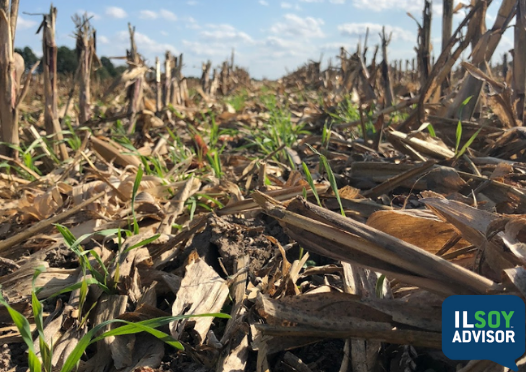ILSOYADVISOR POST
SHOWCASE FARMER: Kelly Cheesewright
The farmer. Kelly Cheesewright has farmed his entire life on the Illinois state line near Dana, Ind.
Environmental challenge. The soils on Cheesewright’s farm are mostly silty clay loams and clay loams, which are susceptible to erosion. To combat this, Cheesewright grows cover crops to prevent erosion and improve soil quality. His first attempts with cover crops back in the 1990s met with limited success.
“We were uneducated in the ’80s and ’90s, but it’s so different now,” he explains.
“We have a better understanding of soil biology and soil chemistry, which helps us better understand the function and the results. Plus, we have more tools in the toolbox. The research is better and the herbicides are better.”
Best Management Practices. For Cheesewright, the cover crop of choice is mainly cereal rye, with some radishes, rapeseed, crimson clover and annual rye grass, all planted in mixes.
He explains that the benefits of cover crops are clear. “We definitely see the benefits, such as the ability of cover crops to pick up the unused nitrates, like in 2012 when we had a severe drought and the corn didn’t use the full load of nitrogen,” he says. “The cover crops sucked up most of the nutrients and recycled them for the next crop. To me, they’re economically and environmentally friendly. And with continuous use, we’re trying to build a better factory and make our soils more resilient.”
Cheesewright emphasizes the importance of early planting in order to get a good crop established and reap the maximum benefits from cover corps.
“As far as cover crops, earlier seeding, in our area in August or early September, is a priority,” he says. “Whether ground-applied or air-applied, you need to find a way to get them planted on time.”
Adding a cover crop to a corn-soybean rotation is not a risk-free undertaking. “When you factor the cost of aerial application and the cost of seed, you can throw away $40 – $50 per acre if you’re not successful, which could mean the difference between profit and loss, especially in a year like 2015,” he says.
Advice to growers. Cheesewright’s advice for growers interested in adopting cover crops is simple: Focus on education in the first year. “The big thing is education, so do your homework and make sure you’re planting the right species, like cereal rye, that you easily can kill.”
He cautions that annual ryegrass may not be a good choice for someone starting out, as it can be difficult to establish and keep alive, then hard to kill in the spring. “You need to know about the species you’re planting. There’s a way to start with friendly species that winterkill.”
He suggests oats and radishes that should be planted by early September in his area. “They winterkill, so you can plant right into it in the spring,” he says. “They’re great for beginners.”
He adds that many growers steer clear of cereal rye for fear that it will get too big, but he says that’s not as much of an issue with soybeans as it can be with corn.
“As long as you kill it at knee-high or less, we’ve had tremendous success, but bigger than that and it will suck up the available nitrogen and won’t give it back for the corn crop to use it.”
Cheesewright adds that he’s been no-tilling for 30 years and has noticed that in severe rain events it helps to have cover crop roots to soak in moisture and reduce runoff and erosion.
“We’re always trying something new,” he says. “We never stop trying something.”





Comments
Add new comment